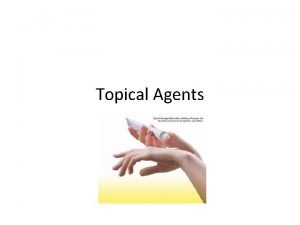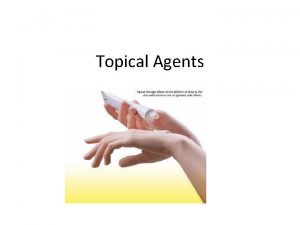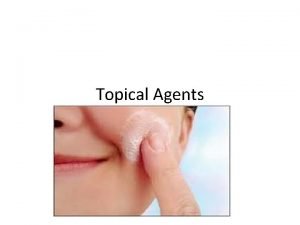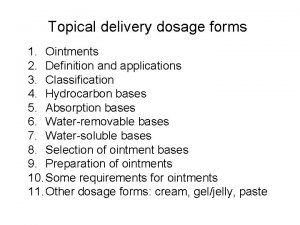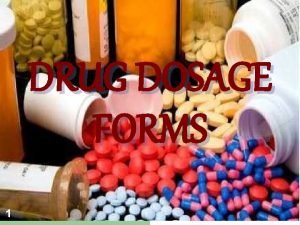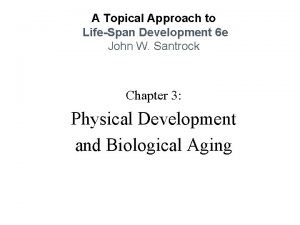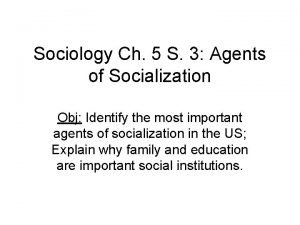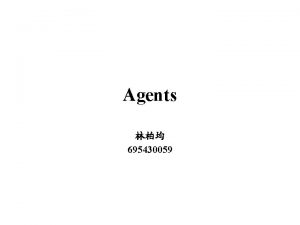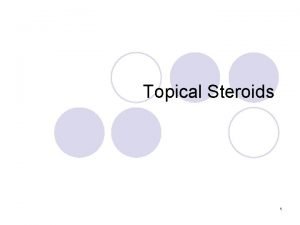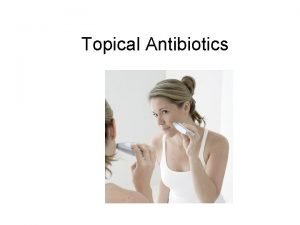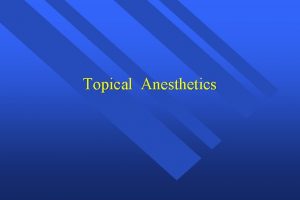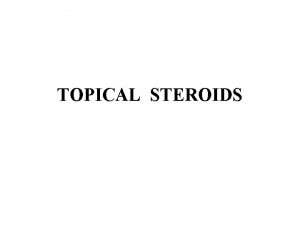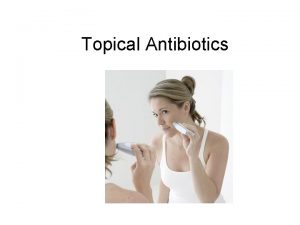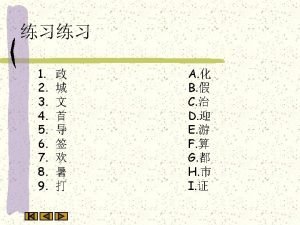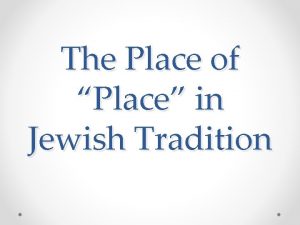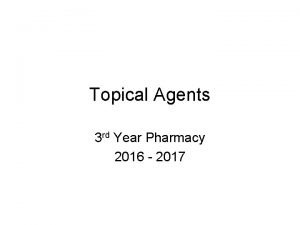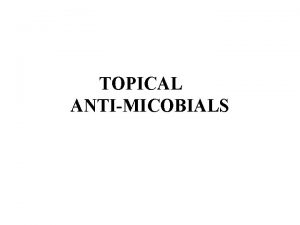Topical Agents Definition Topical Place the use of








































- Slides: 40

Topical Agents

Definition • Topical : Place the use of these drugs or compounds on the surface • Ex: Antiseptic • Systemic: The drugs are absorbed into circulatory system and distributed to various organs or tissues.

Types of inorganic topical agents • The compounds used topically will be divided into broad categories based on their usual action or uses. • There are TWO types: • 1 - Protective agents. • 2 - Antimicrobial agents.

Protective agents • Are substances which may be applied to skin to protect certain areas from irritation. • Properties of protective agents are insoluble in water ( H 2 O), and chemically inert ( unreactive), in order to prevent interactions between the protective substance and the tissue. • Also, small fine partials(large surface area).

Classification of protective agents • 1 - Dusting powders. • 2 -Suspensions. • 3 - Ointments

Talc • Mg. O. 4 Si. O 2. H 2 O • Hydrous magnesium silicate, very fine white powder, smoothly, greasy feeling to the touch( soapstone). • Talc is characterized as fine powder ( 80/100) mesh particle size, odorless, insoluble in water , dil HCl, bases.


Uses of Talc • 1 - It is useful in lubricating, protective dusting, • Can be prevent any friction. • 2 -Used for wound & surgical incision because can produce sterile abscesses • 3 - Used in medical gloves. ( plastic disposable) • 4 - Used in cosmetic may be perfumed • Medical Talc by mixing boric acid with talc as antimicrobial agents.

Zinc Oxide • The chemical formula for Zinc oxide is Zn. O • Is a very fine, oderless, amorphous , white or fait yellow powdwer, can heated 400 -500 ∙C • Zno is insoluble in water, alcohol, but react with dil HCl • Zn. O + HCl ----- Zn. Cl 2 + H 2 O

Uses of Zinc Oxide • 1 - Is a mild astringent and weak antimicrobial agents. Used as powder, ointments to protect the skin. • 2 - Dusting powder used in the treatment of skin ulceration & other dermatological problems. • Medicated zinc oxide by mixing with boric acid as antimicrobial agents.

Calamine • The formula is Zn. O. x. Fe 2 O 3 • Can be synthesized by mixing Zn. O with ferric oxide. • It is a fine powder, water insoluble, alcohols , adhering to the skin.

Uses of Calamine • Calamine can be used as topical protective agent. • 1 - It is USP product used as dust powder, calamine lotion ( applied to skin )pink color. • Calamine is applied to the skin for its adsorbent, protective properties, used in dermatological problems.

• The calamine lotion contain Zn. O and ferric oxide equally mixed Bentonite magma in the solution of Calcium hydroxide. • Phenolated calamine lotion( USP ) contains 1% liquid which provide a local anesthetic and anti- itching action.

Titanium Dioxide • Ti. O 2 as topical protective agent, it is characterized by off white powder color, tasteless, odorless. A 1 to 10 aqueous suspension of the solution is neutral to litmus paper. • It is insoluble in water , HCl. HNO 3, dil H 2 SO 4. • It is soluble in HF, Conc. H 2 SO 4. Also, in H 2 O 2 • Ti. O 2 + H 2 O 2 ---- Ti. O 3 • Tritium dioxide Titanium trioxide

Uses of Ti. O 2 • Ti. O 2 is a protective agent, topically, used as Sun screen light ( UV light radiation) due to its highly refractive index. • Many pharmaceutical preparation as Ti. O 2 cream, 5, 10, . . 25% ointments. • Other organic sun screen agent p- aminobenzoic acid ( PABA). • Ti. O 2 used in cosmetic and paints.

Aluminum • Aluminum ( Al ) is a silver- white metal as protective agents , highly affinity to O 2 forming Al 2 O 3 as protective layer. • It is insoluble in water, alcohols, and uncreative towards HNO 3, H 2 SO 4 • It react rapidly with dil HCl • HCl + Al ------ Al. Cl 3. 6 H 2 O • Aluminum, paste ( Zn. O with base ) used for prevent irritation.

Silicon Polymer • There are inert protective substances occurring in liquid form known as Silicon oils; e. g. dimethyl silicon ( Dimethicon, or Simethicone ) • CH 3 • CH 3 Si-O- ( - Si - O ) ------Si - CH 3 • CH 3 • Very well adhere to skin, but not wound, be avoided contact to the eyes.


Topical Agents 3 rd Year Pharmacy 2016 - 2017

Outline • Classification a- protective b- antimicrobial agents • A- protective products • Talc , Zinc oxide Zn. O, Calamine, Titinum oxide Ti. O 2, Al products& silicon polymer • Antimicrobials • Mechanism 1 -oxidation H 2 O 2, Zn. O, KMn. O 4, Iodine • 2 - Halogenations Na. OCl • 3 - protein ppt Ag. NO 3.

Protective Agents • Protective • Any agent that isolates the exposed surface from harmful or annoying stimuli • Properties of protective agents: • Insoluble in water Chemical Inertness Adsorbent

• Deeper penetration of topical agents are also seen in many cases which are beneficial. (Penetration of antiseptics into the tissue • below the skin prevents the possibility of deeper in fections-( •

Protective Agents Talc • Talc (Mg 3 Si 4 O 10(OH)2 • protective: native hydrous magnesium silicate, common name and chemical formula. • Soapstone can be grinding in 80/100 mesh particle size. • As grease touch. , insoluble in water, • Uses as protective agents , as lubricants and in pharmaceuticals, as cosmetics, ceramics, for plastic cloves,

Zinc Oxide ( Zn. O ) • White or fait yellow color powder, insoluble in water. Other formulation as Zinc Oxide ointment for adult, & Zinc Oxide in Glycerin for children. • Dusting powder, used astringent and protective topical agent, mild antiseptic, used in the acne preparation, eczema, & psoriasis • It is usually used in the manufacture of plasters.

Calamine Zn. O and Fe 2 O 3

• It used as dusting powder, lotions, ointments, as smoothing agents, for sunburn, eczema, urticaria. Calamine lotion is very popular.

Boric Acid H 3 BO 3 • Is a weak acid, used as antiseptic, and as chemical precursor for many reactions. • Uses: • 1 - Antiseptic • 2 - dilute solution for eye wash • 3 -Acne • 4 - Vaginal douche against bacteria. • 5 -It used as protective against athlete foot.

Titanium dioxide Ti. O 2 • Topical protective agents as cream is used against sunscreen to protect the skin aganist ultra-violet light ( U. V. ). • The organic topical protective agents is • P-aminobenzoic acid ( PABA).

Antimicrobial Agents • Antiseptic: • Any agent which kills or inhibits the growth of microorganisms found in living tissue. • Disinfectant: • Any agent which kills or inhibits the growth of microorganisms found in inanimate objects. • Germicide: • General term for fungicide, bactericide, amoebicide

Mechanisms of action of antimicrobials • There are THREE proposal mechanisms: • 1 -Oxidation 2 -Halogenation Protein Precipitation 3 -

Oxidation cell membrane of bacteria • SH S---S

Halogenation the protein of the cell membrain • H 2 N CHR CO NH CHR 1 -- (HOCl) Na. OCl H 2 NCHRCONCl CHR!. . .

Protein pption that kill the microbe • H 2 NCHR 1 CONHCHR 2 --- • Ag. NO 3 • H 2 NCHR 1 CONHCHR 2 -- • Ag

Hydrogen Peroxide H 2 O 2 • liquid not store in glass bottles because it decompose , it store in white plastic container, keep in cold dark place to prevent decomposition. • There are many uses : • 1 - Antiseptic for wash wound , teeth and ear • 2 -Bleaching color ( hair ). • 3 - Laundry for cloths.

• Sodium Perborate • Antimicrobial : Composite of H 2 O 2, Na. BO 2 and Na. OH Used as bleaching agent in non-chlorine laundry bleaches

Potassium Permanganate KMn. O 4 • Chemically is a strong oxidizing agent, solid purple crystalline , odorless. • Store in well closed container. • Uses: • 1 - Oxidizing agent for skin disease in different concentrations 1: 5000, 1: 15000 • 2 - used in swimming pool for athlete foot. • 3 - Strong oxidizing for many organic reactions.

Iodine I 2 • It is dark violet , insoluble in water , but the • I 2 + KI = I 3 – Complex soluble in water as iodine solution, soluble in alcohol known as tincture iodine • Iodine solution weak solution ( 25 g I 2 + 25 g KI ) in 100 ml • And strong solution ( 50 g I 2 + 50 g KI ) in 100 ml. • Iodine preparations and compounds • Antimicrobial property due to oxidation and Iodination disinfectants • A chemical reagents in analytical reagent. • In drug synthesis. • In Povidin iodine as new product.

Povidone Iodine ( PVP – I) • is a stable chemical complex of poly vinyl pyrrolidine iodide. It is broad spectrum antiseptic for wounds. It is used disinfectant.

2 - Halogenation • Dakin's Solution • Sodium hypochlorite solution, (usp) Contains 4 -6% of Na. OCl, • It is made from bleach that has been diluted and treated to decrease irritation. Chlorine, the active ingredient in Dakin's solution, is a strong antiseptic that kills most forms of bacteria and viruses. .

3 - Protein ppt (Silver Nitrate Ag. NO 3) • Prepare as 1% Ag. NO 3 , protective from light due to oxidation. Effective against gonococcal organism. • Antimicrobial activity of these compounds is due to protein precipitant action. • 1% used eye newborn babies.
 Define topical agents with example
Define topical agents with example Definition of topical agents
Definition of topical agents Ray-dee-og-rah-fee
Ray-dee-og-rah-fee Place place value and period
Place place value and period What is a disturbance that transfers energy
What is a disturbance that transfers energy Disturbance that transfers energy from place to place
Disturbance that transfers energy from place to place Topical approach definition
Topical approach definition Water soluble bases
Water soluble bases Dosage form of drug
Dosage form of drug Topical approach meaning
Topical approach meaning Topical approach definition
Topical approach definition Agents of socialization
Agents of socialization Primary agent of socialization
Primary agent of socialization Hình ảnh bộ gõ cơ thể búng tay
Hình ảnh bộ gõ cơ thể búng tay Bổ thể
Bổ thể Tỉ lệ cơ thể trẻ em
Tỉ lệ cơ thể trẻ em Gấu đi như thế nào
Gấu đi như thế nào Thang điểm glasgow
Thang điểm glasgow Bài hát chúa yêu trần thế alleluia
Bài hát chúa yêu trần thế alleluia Các môn thể thao bắt đầu bằng từ đua
Các môn thể thao bắt đầu bằng từ đua Thế nào là hệ số cao nhất
Thế nào là hệ số cao nhất Các châu lục và đại dương trên thế giới
Các châu lục và đại dương trên thế giới Cong thức tính động năng
Cong thức tính động năng Trời xanh đây là của chúng ta thể thơ
Trời xanh đây là của chúng ta thể thơ Cách giải mật thư tọa độ
Cách giải mật thư tọa độ Phép trừ bù
Phép trừ bù Phản ứng thế ankan
Phản ứng thế ankan Các châu lục và đại dương trên thế giới
Các châu lục và đại dương trên thế giới Thể thơ truyền thống
Thể thơ truyền thống Quá trình desamine hóa có thể tạo ra
Quá trình desamine hóa có thể tạo ra Một số thể thơ truyền thống
Một số thể thơ truyền thống Cái miệng xinh xinh thế chỉ nói điều hay thôi
Cái miệng xinh xinh thế chỉ nói điều hay thôi Vẽ hình chiếu vuông góc của vật thể sau
Vẽ hình chiếu vuông góc của vật thể sau Thế nào là sự mỏi cơ
Thế nào là sự mỏi cơ đặc điểm cơ thể của người tối cổ
đặc điểm cơ thể của người tối cổ Ví dụ giọng cùng tên
Ví dụ giọng cùng tên Vẽ hình chiếu đứng bằng cạnh của vật thể
Vẽ hình chiếu đứng bằng cạnh của vật thể Vẽ hình chiếu vuông góc của vật thể sau
Vẽ hình chiếu vuông góc của vật thể sau Thẻ vin
Thẻ vin đại từ thay thế
đại từ thay thế
